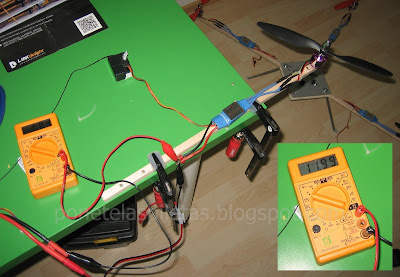QUADCOPTER - 3rd Delivery - Range Estimation & Thrust
AUTONOMIA / RANGE
Un quadcopter es, básicamente, un ladrillo volador... dependiendo de qué pais seas, tal vez un piano volador... Ya te imaginarás lo que puede pasar si en pleno vuelo se te acaba la batería...
A quadcopter is, basically, a flying brick.. or perhaps a flying piano, depending from where are you originally from... You can imagine what could happen if in the middle of your flight your batteries run out of power...
Así pues, es fundamental hacer una estimación de autonomía, para aterrizar antes de la catástrofe... Y esta estimación es muy fácil de realizar.
Therefore, is extremely important to do a range estimation, to do a safe landing instead of having a catastrophe... and this estimation is quite easy to do.
Lo que haremos es medir la corriente consumida por uno de los motores a plena carga. Con plena carga no solo me refiero a "motor a pleno", sino también con la hélice montada.
What we are going to do is to measure the current with one of the motors full loaded. And with full loaded I'm not referring to "full throtle", but also with the propeller mounted.
Luego multiplicaremos por la cantidad de motores (en mi caso 4), estimaremos un extra de miliamperios para la electrónica, aplicaremos algún factor de seguridad que tenga en cuenta la pérdida de carga de la batería a lo largo de su vida, y dividiremos la corriente total resultante por la capacidad de nuestra batería. Así obtendremos el tiempo que podremos utilizar nuestro quadcopter en el aire de modo seguro.
Then we will multiply the current by the quantity of motors (in my case 4), we will estimate an extra current comsumption for the electronic, we will apply a safety factor in order to take into account the lose of life of the battery and, finally, we will divide the resulting current by the capacity of our battery. In this way we will obtain the time that we can use our quadcopter in a safe way.
Les dejo el ejemplo para mi quad:
The example for my quad:
Datos de la Batería / Battery Data
V = 11.1V
C = 3300 mAh (3,3 Amper x hour)
Consumo del motor / Motor current comsumption
I = 12A
Consumo motores / Motors current comsumption
Im = 12A x 4 = 48A
Electronica / Electronics curent comsumption
Ielec = 0,5 A
Factor de vida de batería (seguridad) / Battery life factor (safety)
SF = 0,8
Consumo total estimado / Estimated total comsumption
It = (Im + Ielec) / SF
It = 60 A
Autonomía estimada / Estimated range
t = C / It
t = 0,055 hrs = 3,3 min
Por supuesto que este cálculo es conservativo, ya que durante un vuelo normal no vamos a usar los motores a su máxima potencia todo el tiempo. Lamentablemente de momento no tengo como medir el empuje real producido por motor y hélice, por lo que me es imposible estimar qué potencia será necesaria para mantener el quad en posición recta y nivelada, o estimar una curva de potencia para un vuelo típico. Mi estimación es que probablemente la autonomía sea de entre unos 6 a 10 minutos, sino mas.
Of course that this analysis is conservative, because during a normal flight we are not going to extract the maximum power from the motors at every moment. I'm afraid that by the moment I'm not able to measure the real thrust produced by the propeller, so it's quite hard to estimate how much power will be needed to keep the qued levelled, or to estimate a typical flight power curve.My estimation is that, probably, the range will be around 6 to 10 minutes, or even more.
EMPUJE / THRUST
De acuerdo con la data disponible del motor, la máxima potencia que puede erogar es 255W y tiene una relación velocidad-tension de 1000KV (1000 RPM por cada voltio). Considerando que la corriente necesaria para generar 255W de potencia a 11,1V es 23A (I = P/V) y que durante la prueba que he realizado el motor a máximo empuje estaba consumiendo 12A, se puede estimar las RPM real para dicha situación, y posteriormente obtener el empuje mediante alguna calculadora de empuje que hay por la web, como por ejemplo ESTA.
In accordance with the information of the motor, the maximum power produced is 255W and it has a relationship speed-voltage of 1000KV (1000 RPM for every Volt applied). Taking in consideration that the current needed to generate 255W @ 11,1V is 23A (I = P/V), and that during the test that I've done I get a max current of 12A, it's possible to estimate the real RPM for that precise situation, and afterwards get the thrust using one of the calculators available in the internet, like for example THIS.
Motor = C2830 1000KV
Propeller = 10x4,7
I = 12A (current from test)
Imax = 255W / 11,1V = 23A
RPMmax = 1000KV x 11,1V = 11000 RPM
23A ----- 11000 RPM
12A ----- x = (12 x 11000) / 23 = 5740 RPM
10x4,7 prop @ 5740 RPM = 0,575 kg

No comments:
Post a Comment